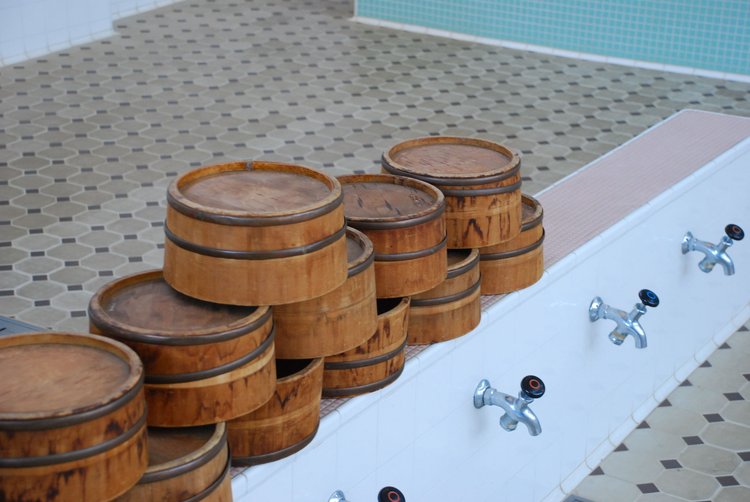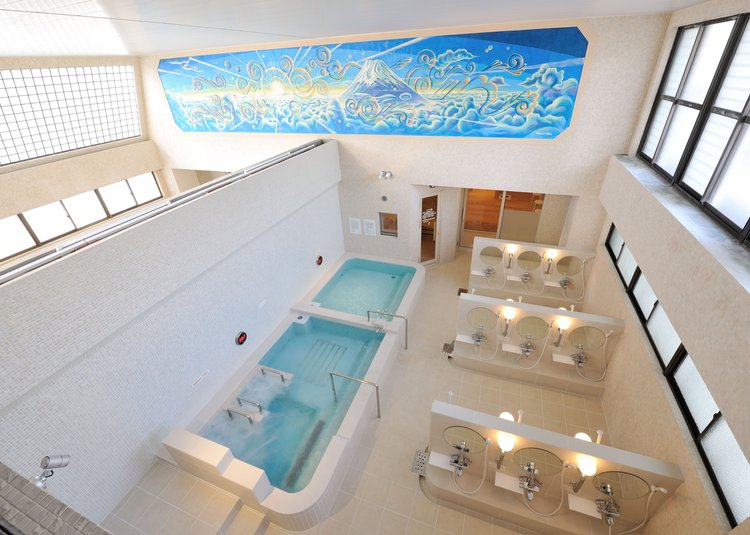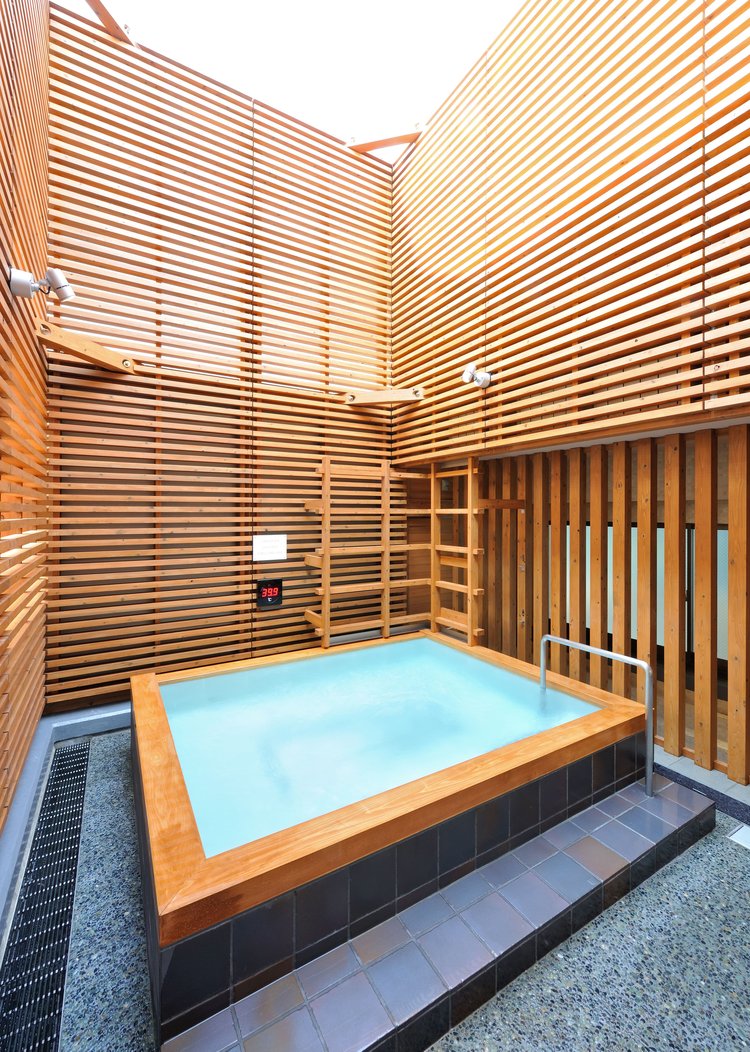Amidst the Swirling Mist of Hot Baths
Taiwanese Hot Baths and Japanese Sento by a Taiwanese Writer in Japan, Zhang Weizhong
Text / 張維中
Picture provided / 今井健太郎建築事務所、張維中
Jazz music rambled softly around the space, mixing with modern variations. The sound of laughters came from all directions. When I listened to it for a while in the mist, there was a sense of psychedelic echoes, blending into a rhythm of murmuring people. I was in the middle of it. My soul gradually relaxed with the soothing flesh. I felt sleepy with pleasure and I even got a hazy vision.
Oh wait, don't get me wrong. I was not in a nightclub, and not doing anything weird. It was the "sento" near my home, a Tokyo bathhouse that overturns the traditional image. A few years ago, after a young man took over the business, the mural of Mount Fuji disappeared, the decor was changed to a cool space gray, and the music was switched to jazz. Sento and jazz, two things that would never have been linked in the past, now mix perfectly in the steamy ambience.
The main element of sound in a sento is, of course, the sound of water. The sound of water emitted by the bathers entering and exiting the bath, together with the crisp sound of water falling on the floor from the whole row of bathing faucets on the wall, was like a sound source that struk my memory, occasionally reminding me of the past of bathing in Taiwan.
The Similarities and Differences Between Taiwanese Hot Baths and Japanese Sento
When I returned to Taiwan years ago, I often visited Beitou, escorting my Japanese colleagues on business trips or Japanese friends who came to tour. My friends found a sense of emotional connection between Taiwan and Japan in Beitou hot spring town, whereas I associated it with my memories of bathing in hot springs when I was growing up. When I stood in the Beitou Hot Spring Museum and looked at the large bathhouse, which is now a display space, I could not help but put on my own filter every time I looked at it. As I imagined the mist of hot water steaming up in front of me, I seemed to hear the chattering and laughter. Then, there was hot water in the pool, and people were moving around in the hot water.
I have such a lively impression of the "hot spring bath" scene. During my college years and the years working in Taiwan, I went to Beitou most frequently to take a bath. At that time, when everyone was riding motorcycles, I often rode my motorcycles with friends to the Chuantang Spring (川湯溫泉) on the Hsing-Yi Road in Beitou, and sometimes I even rode to the Ma-Chu Hua-Yi Village Hot Spring (馬槽花藝村溫泉) at midnight. When I rode my motorcycle to the Hua-Yi Village in the mountains, one third of the way was always immersed in the foggy scenery, which was really tiring and far away. I really don't know how I got the leisure to do so back then.
These are the hot springs that I often visited, and their business was always booming. If there was a cold snap in winter, the business would be even better. When you stepped into the hot springs, you would laugh at yourself as if you were going to get into dumpling soup. How could so many people fit into the pool? One winter, many years later, when I took my Japanese friends to Kawayu, they were shocked. In Japan, unless it's a so-called "super sento", it's rare to see so many people at a typical hot spring hotel or sento.
For those who live in Taipei, going to Beitou or Yangmingshan to take a bath in the cold weather is an everyday thing. In the same scenario, in Japan, one would not go to a hot spring, but to a sento, that is, a Japanese public bathhouse. In Taiwan, the term "bathing" means "soaking in a hot spring", or "bathing in a hot spring", which is what some people are used to saying. Most of the sentos in Japan are not hot springs except for a very small number of sento or super sento boasting the use of hot springs, otherwise most of them are just hot water pools.
Going to a sento and going to a hot spring are basically two different concepts. A sento is a public bathroom or a public bathhouse, which is mostly found in residential areas. They do not exist for toursim and are not very spacious, but only to satisfy people's needs for bathing and soaking in hot water. People go home soon after taking a hot bath. As for the hot spring baths, they are a bit recreational and leisurely in nature, which is more similar to the way Taiwanese people think. They think of it as a place to go for fun, a place they plan to visit. In Taiwan, strictly speaking, there are fewer public bathhouses like sentos, both in form and in meaning. Therefore, sento culture has become a characteristic of Japanese society to us.
Sento is popular in Japan because in the early days there were no proper bathrooms at home, and it was not easy to take a bath in the days when there were no electric water heaters. However, almost all households now have a bathtub in the bathroom, but people still feel like going to sento simply because they prefer the open feeling of stretching their arms and legs in a large bath.
Sento is not only a place to take a bath, but also a place for sharing feelings. When you go with your family, friends or even colleagues, you may occasionally meet your neighbors and chat with them while taking a bath. Whether it's about life or business, the conversation is very casual. Perhaps due to the relaxation of the body and mind, even the most serious people and issues can be softened by the hot water, which may be a solution to life's difficulties. The role of a sento is sometimes similar to that of an izakaya, as it is a social area for interpersonal relationships.

Sento is not only a place to take a bath, but also a place for sharing feelings.(Picture provided:張維中)

Sento is a public bathroom or bathhouse, mostly found in common residential areas, and is one of the representative cultures of Japan.(Picture provided:張維中)
JAPANese Design Sento Trend
Sento flourished in the mid-Showa era. Due to the change of lifestyle, the ageing operators, and outdated buildings, several sentos disappear every year. Young people no longer show interest in sento. However, in recent years, a wave of "design sento" has emerged in Japan, bringing back the attention of young people. Like the jazz-infused Minatoyu (sento) near my house, which was originally dim and outworn, has been transformed after a new generation took over the business. There are many old sentos in Tokyo that have been revived.
They hired a team of architectural design professionals to completely transform the space. Some of them subvert the stereotypical image of the décor of the bathhouse, while others retain the traditional features of the bathhouse, such as the painted murals. The trendy concept is shown in the bathhouse's moving routes, lighting design, and logo identification system.
Architect Kentaro Imai is a pioneer in the design of sento. The Ohirayu (大平湯) designed by him is the inception of the Tokyo design sento. Among the sentos he designed, I prefer the Bright Spring (光明泉) in Nakameguro. The surroundings in this area are so refreshing that you can walk along the Meguro River, and enjoy cherry blossoms or have coffee. Once you are tired, go to a sento to get rid of your fatigue. After that, you may go to "AFURI" for a bowl of yuzu ramen if you are hungry. A perfect package! I also recommend the 90-year-old Bunka Bathing Spring (文化浴泉). In 2011, it also became a popular santo next to Shibuya thanks to the skillful hands of Kentaro Imai. The mural of the bathhouse is painted by the famous artist Morio Nakajima, which adds the finishing touch to the sento.

Also designed by Kentaro Imai, "Bright Spring" is located in the Nakameguro area, and it is a perfect trip to the nearby famous ramen store "AFURI" for a bowl of yuzu ramen after soaking in the hot spring.(Picture provided:今井健太郎建築事務所)

(Picture provided:今井健太郎建築事務所)
The future of Sento culture
Over the years, besides renovating the hardware of the space to attract young people to continue to go to sento, the owners have also started to inject a new soul into sento. They even put their sento in a different role as a new platform for the media during the non-bathing business hours.
For example, Ume-yu (梅湯) in Kyoto has been renovated with a new look. Because jazz music is also played indoors, a special jazz performance was held in the sento on a non-bathing day with the participation of local people. The sunrise bath (日出湯) in Inari-cho, Ueno, has launched an educational platform project with the REBIRTH PROJECT, called the Naked School (はだかの学校). Classes are held once a month for fifteen minutes with about a dozen students. The classes offer lecturers on topics related to the region, and the classroom is moved into sento. Just like a normal visit to a sento, both teachers and students must enter naked (men and women separately) and listen to the lectures and interact with each other while relaxing in the bath. Another restaurant in Ueno, Longevity Bath (壽湯), has collaborated with the fashionable clothing brand BEAMS. A manga artist was invited to create a new feel for the curtains and murals at Sento. A series of T-shirts and peripheral products with the theme of sento illustrations were launched, and a counter for the theme was displayed in the BEAMS store.
Taiwan does not have sento, but it has a unique culture of hot spring bathing. In this new era, how to add more fresh and interesting feelings to hot spring bathing, and even a platform for exchange of activities? After the epidemic, take a trip to Japan to experience sento, and I believe there may be some answers hidden in the swirling mist of the hot soup.


With a history of 90 years, "Bunka Bathing Spring" was renovated in 2011 by Kentaro Imai and became a trendy santo next to Shibuya.(Picture provided:今井健太郎建築事務所)
